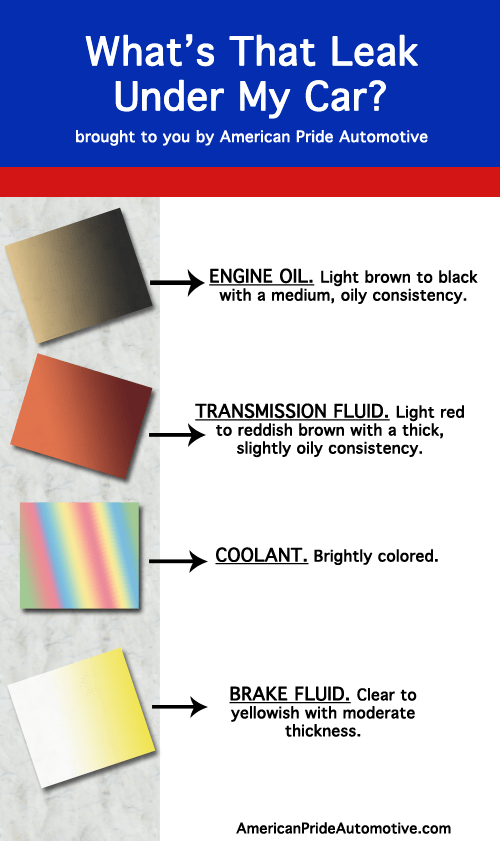WHAT IS LEAKING FROM MY CAR?
American Pride Automotive • December 29, 2014
Sometimes one of the first signs of a car trouble is a mysterious puddle of fluid under the vehicle on the driveway. The first instinct for many car owners is to assume an oil leak, but that may or may not be the case. In fact, there are several different kinds of common leaks, each with its own auto repair implication (and some that don’t require repair at all!). Next time you notice fluid under the car, consult this post to get an idea of the possible cause. Then call American Pride Automotive for official vehicle diagnosis and repair.
WHAT TO LOOK FOR
You should be able to get an idea of the source of the leak based on the liquid’s color, location and consistency.
When you encounter a fluid leak, it’s likely that the surface (a concrete or gravel driveway, asphalt, etc) will obscure the color of said fluid. Since color is the most indicative aspect of fluids in a vehicle, you’ll want to put a light colored material under the car and check again the next day. Newspaper or white cardboard are ideal. Once you have the color profile, you can compare it to the following descriptions:
Black or Light Brown
Black or light brown fluid with a moderate consistency generally indicates an oil leak. The color may vary based on how long it’s been since your last oil change. A little drip of oil here or there isn’t critical, but if you notice significant puddles, get the vehicle into an ASE certified mechanic ASAP. It could indicate a bad gasket, improperly secured oil filter or oil plug, or another old/corroded part of the oil system. Ultimately, if a car loses too much oil, it will have adverse effects on the engine and vehicle as a whole.
Light to Dark Red/Reddish Brown
Thick fluid of varying shades of red is almost certainly transmission fluid. You’ll find this leak under the middle-front of the vehicle. You most likely have a loose pan or drain plug, cracked gasket or a corroded seal. Because transmission fluid is such an essential component of keeping the transmission cool, lubricated and functional, it’s important to locate the source of the problem quickly. Neglecting to do so will can lead to transmission failure and a need for repair or replacement. Sidenote: Some power steering systems use transmission fluid as lubricant (while others use a dedicated fluid). If the leak is directly under the wheel and you are having trouble turning the steering wheel, you may have a power steering fluid leak.
Green, Yellow, Pink or Blue
Brightly colored leaks are almost always engine coolant. These indicate a problem with the cooling system and are often caused by a blown gasket, cracked radiator hoses and seals, or a broken engine block. Unless you have an older model vehicle (older cars blow off excess coolant when the engine gets especially hot…so in that case a “leak” might just be excess fluid), you should get the vehicle into a mechanic right away.
Clear or Yellowish
If you notice clear or yellow fluid of a moderate thickness near the wheels or under the brake pedal, you may have a dangerous brake fluid leak. Don’t try to drive your car if you suspect a brake fluid leak, as insufficient fluid can lead to brake failure.
Clear
Especially during summer when running a car’s AC frequently, you may notice consistent, clear, watery fluid that appears to be a leak. Don’t panic. This is almost certainly water–condensation from the air conditioner and does not signal a problem.
For quick info, consult this chart:

No matter the nature of your leak, the expert auto technicians at American Pride Automotive are here to help. We specialize in engine repair, cooling system service, brake repair and replacement, and transmission repair. Call or contact us today to schedule an appointment.

You’re driving home at night and it is raining cats and dogs. You can’t see but 20 feet in front of your car, but you’ve slowed down and are being extra cautious, so what could go wrong? Then you feel it. A sinking Cl-clunk. Maybe that “puddle” you saw ahead of you was deeper than just a puddle. Before you know it, your car is stalling in the high water in the middle of the road. Now what? First off, don’t panic. Turn on your hazards and crank the ignition once. If the car starts, make it dry land and pull over to assess the damage. If it does not start the first time, do not try to start it again. Doing so can result in a hydro locked engine and will likely necessitate the rebuilding or replacement of the engine. Unfortunately, if you find yourself stalling in water at all, your vehicle will probably need costly repairs. The best way to avoid water damage is to practice safe and smart driving in wet weather, which brings us to Part 2 of the Everything Auto “Blame it on the Rain” series (Find Part 1 here). Take heed of these severe weather driving tips: 1. TAKE NO CHANCES ON PUDDLES Even if the standing water ahead of you looks shallow enough to drive through, think twice. If the water is “rushing” or if other drivers are making a point to avoid it, don’t assume that your vehicle is the exception. Additionally, you never know the hazards that lay at the bottom of a puddle. Hidden potholes or debris can pierce your tires and jostle your alignment and suspension system. 2. IF YOU MUST TAKE A CHANCE, TAKE IT SLOW AND STEADY When you deem it necessary and safe to drive through water of questionable depth, go slowly. Speeding through a puddle, even a shallow one, can splash water into your vehicle’s intake and critically harm the engine. Like we mentioned last week, after driving through standing water, lightly tap your brakes to make sure they aren’t saturated and to dry them off. 3. KEEP A ROADSIDE EMERGENCY KIT HANDY Sometimes, no matter how careful you are on the road, accidents and vehicle malfunctions happen, especially in wet severe weather. That’s why it is extremely important to keep emergency supplies ready in the trunk for the worst case scenario. You can buy a preassembled one, but it is cheaper (and more rewarding) to assemble your own. What should you include? Edmunds.com provides an excellent comprehensive list of items, a few of which include: 12-foot jumper cables Four 15 minute road flares Two quarts of oil A gallon of antifreeze A first-aid kit. Find the rest of the list here We hope that this series has given you helpful safety insights and tips for driving in the rain! Remember that American Pride Automotive is always here to help and ready to answer any and all of your auto repair and maintenance questions! Call or contact us today.
